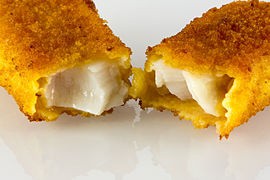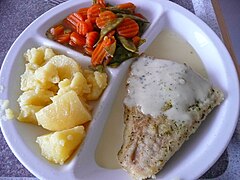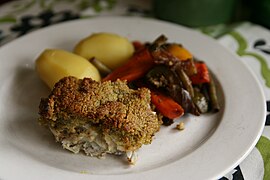Koehler (fish)
| Charcoal burner | ||||||||||||
|---|---|---|---|---|---|---|---|---|---|---|---|---|

Coalfish ( Pollachius virens ) |
||||||||||||
| Systematics | ||||||||||||
|
||||||||||||
| Scientific name | ||||||||||||
| Pollachius virens | ||||||||||||
| ( Linnaeus , 1758) |
The coalfish or cabbage fish ( Pollachius virens ) belongs to the cod family and thus to the order of the cod- like fish. Fishermen and anglers usually call it "Koehler". In the trade, however, it is almost exclusively sold under the approved trade name of saithe for reasons of sales promotion , and is thus incorrectly associated with the salmonid family ("trout fish", "salmon fish").
Name and delimitation
The species is also known as Pollack or Pollock in English and is to be distinguished from the Pollack ( Pollachius pollachius ; also Steinköhler , Kalmück or Kohlmaul ), which occurs in the Northeast Atlantic and Mediterranean , and the Pacific Pollack ( Gadus chalcogrammus ; also Alaska-Pollack or Alaska- Saithe ), both of which also belong to the cod family.
The spread in trade and catering trade name pollock is the extent confusing, as this species is not the salmon counts to the family of salmonids include ( "trout fish", "Salmon Fish"), but to the cod-like fish. In this trade names (as in the as Alaska pollock designated Alaska pollack ) is a historic trade name from the time when the cod species and Dorschartige first time as salmon substitute were used. The food industry took over the historical name in order to be able to better market the fish fingers, mostly produced with these fish .
features
The body of the coalfish is elongated and it has three dorsal fins and two anal fins that stand close together. The side line , a clearly visible light stripe, runs parallel to his back, where he is mostly pitch black and the color merges over the flanks into a silvery-white shiny underside. The older animals can be recognized by their slightly protruding lower jaw. It is noticeable that the chin thread characteristic of cod is mostly missing.
Koehler can reach an age of up to 30 years and are up to 1.20 meters long and up to 17 kilograms. The world's largest documented coalfish, a fish weighing 22.3 kg, was caught by an angler at Saltstraumen in Northern Norway, but professional fishermen have allegedly caught coalfish weighing well over 40 kg.
Occurrence
The coalfish occurs in the entire North Atlantic and in the northern North Sea , and more and more often in the Baltic Sea . It lives near the coast and in the open sea and can be found up to a depth of 250 meters.
Way of life
The coalfish is a pelagic schooling fish . The main food source of the young animals are crustaceans and fish spawn , while adult coalfish hunt smaller schooling fish (herring, sprat).
Use, "saithe"
The coalfish is the eighth most important food fish in Germany (approx. 2% of the fish supply in 2016) and comes on the market as fresh, salt or dried fish , colored as saithe in oil and as frozen fillets .
The name "saithe" is (like " Alaskan saithe ") an invention of the food industry and is based on the use of meat as a red-colored " salmon substitute " (from the time before the introduction of salmon farming ) . Historically, there was initially a need for this due to the collapse in imports of real salmon during the First World War , then due to the declining salmon catch in Central Europe. In Germany, the salmon died out in the 1950s. The charcoal meat is said to have been dyed red as a salmon substitute as early as the First World War, the process and the designation as "salmon substitute" perhaps only later became more common in order to improve the initially unsatisfactory sales of charcoal meat. In the 1930s the trade replaced the designation “Kohler” or “Kohlfisch” with “Pollack”, either to emphasize its importance as a salmon substitute, or to (seemingly) upgrade the product. The marketing methods gained in success and retained it when real salmon became available again through aquaculture farming . At the end of the 1990s the coalfish was overfished for its part .
- Examples of its use as food fish
Fish fingers , here made from "Alaska pollock"
literature
- Hans-Heinrich Reinsch: Köhler and Steinköhler: Pollachius virens and P. pollachius. (= Die Neue Brehm-Bücherei. Volume 496). A. Ziemsen Verlag, Wittenberg Lutherstadt 1976.
Web links
- Pollack, cabbage fish, coalfish on Lebensmittellexikon.de (biology, trade, preparation, ingredients, literature)
- Koehler on Fishbase.org (English)
- Köhler at FAO , Fisheries and Aquaculture Department (English)
- Alaska pollock in the fish lexicon of the fish processing company Deutsche See
Individual evidence
- ^ Federal Agency for Agriculture and Food: Fish labeling .
- ↑ Sainsbury's gives unfashionable pollack a makeover
- ↑ Gadus chalcogrammus fish stocks online - information portal of the Thünen Institute for Baltic Sea Fisheries, accessed on September 25, 2016.
- ↑ Pacific Pollack on Fishbase.org , accessed September 11, 2017.
- ↑ Heidi Driesner: (K) a fish turns 60. n-tv , October 3, 2015, archived from the original on December 6, 2016 ; Retrieved February 20, 2017 .
- ↑ RP Online: Pollack - the invented fish. April 3, 2013, accessed February 20, 2017 .
- ↑ market shares. Fish Information Center e. V., archived from the original on April 6, 2018 ; accessed on October 10, 2018 .
- ↑ a b c d e Label fraud: Pollack - the invented fish. RP online , April 4, 2013, accessed October 10, 2018 .
- ↑ a b c Pollock and egg baguette. North Sea (restaurant chain) , accessed on October 10, 2018 (ingredients, etymology, fishing area): "Did you know that the saithe has nothing to do with the salmon?"
- ↑ a b c Pollack, cabbage fish, coalfish. Trade names. In: Lebensmittellexikon.de. Retrieved October 10, 2018 .




